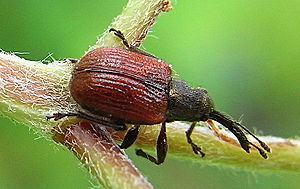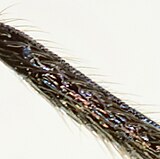Red-brown apple fruit cutter
| Red-brown apple fruit cutter | ||||||||||||
|---|---|---|---|---|---|---|---|---|---|---|---|---|

Red-brown apple fruit cutter |
||||||||||||
| Systematics | ||||||||||||
|
||||||||||||
| Scientific name | ||||||||||||
| Tatianaerhynchites aequatus | ||||||||||||
| ( Linnaeus , 1767) |
The reddish brown apple pod ( Caenorhinus aequatus or Tatianaerhynchites aequatus ) is a beetle that is immediately recognizable as a weevil due to the snout-shaped extension of the head. Within the large group of weevil-like beetles, the beetle belongs to the leaf rollers (Attelabidae), which today have the rank of a family of their own , and here to the subfamily Rhynchitinae. It is not uncommon to find the beetle in spring on hawthorn or fruit trees, mainly apple trees. The term “apple fruit cutter” is also used for the metallic lavender purple apple fruit cutter ( Rhynchites bacchus ). Both can pierce young apple fruits and thereby reduce their quality. The apple blossom piercer, on the other hand, pricks the flowers and belongs to the weevil family ( Curculionidae ).
Notes on the name
Curculio longirostris aeneus, elytris rubris, rostro nigro elongato ( Latin ore-colored weevil with long proboscis, elytra red, proboscis black and elongated ). With these words, Linnaeus first described the species under the name Curculio aequatus in 1767 . The species name aequātus means equalized .
From the genus Curculio the genus Attelabus was split off first, from this in turn Rhynchites , of which Coenorhinus or Caenorhinus . The genus Tatianaerhynchus was only established in 2002. The word stems -rhin- (from ancient Greek ρίς, ρίνος rhis, rhinós) and -rhynch- (from ancient Greek ρύγχος rhýnchos) both mean proboscis.
The species aequatus is the only species in the genus Tatianaerhynchites .
Description of the beetle
The beetle is stocky and 2.7 to 4.5 millimeters long. The species differs slightly from the blue and green similarly built species , which are sometimes difficult to distinguish, in terms of color. The body is metallic, shiny bronze and the wing covers are red to brownish-red in color. The seam of the elytra usually has a narrow, short, indistinct blackish stripe behind the label. The antennae and legs are black. The top is clearly hairy.
The head is not clearly pinched at the back. The trunk is not kinked. It is slender, curved down and longer than the pronotum. It is significantly narrower than the broad forehead. In the females it is longer than in the males. The mouthparts are at the tip of the trunk. As with all weevils, the upper lip is stunted. The jaws are small, the upper ones exposed. The jaw probes are rudimentary and rigid. There is no sensor pit on the trunk. The eleven-part antennae are deflected approximately in the middle of the trunk. The first antenna element is hardly longer than the following and is not angled in relation to them. The last three links form the loosely jointed club. The last antenna element is finely curled and thus simulates the existence of another antenna element. The round eyes are bulging.
The pronotum is hardly longer than it is wide in the middle. It is narrowed at the front and rounded at the sides.
The elytra are at most 1.3 times as long as together wide. They leave the end of the abdomen ( telson ) uncovered. The shoulders are well developed, the elytra together significantly wider than the pronotum. The sides of the wing covers are slightly widening in the front area. At the top, the wing covers are individually rounded. The points on the wing covers are arranged in rows. The row of dots next to the label (Skutellar stripe) is greatly shortened and ends in the first quarter of the wing cover. The ninth and tenth point stripes (the two furthest out point stripes) unite in the middle of the elytra (Fig. 8).
The trochanters sit up together with the thighs of the hip. The rails have a finely notched edge on the outside (Fig. 4). They do not have spike-shaped or hook-shaped extensions. The tarsi are all four-part. The first tarsal link is no longer than the second and third combined. The third tarsal link is split in two lobes to accommodate the claw link. The claws are not fused and split (Fig. 7).
From below you can only see 5 parts of the abdomen (abdominal segments). The first and second abdominal segments are equally wide at the narrowest point. The rear hips are narrower than any of these abdominal segments.
Construction of the larva
The larva is yellowish-white and footless, soft-skinned and thick. It becomes 4 to 4.5 millimeters long.
biology
The species occurs in dry locations on trees and shrubs, for example on dry and warm slopes, sun-exposed forest edges, less often in gardens, and on fields.
The beetles overwinter hidden behind bark scales. In spring they feed on the leaf and flower buds. After fruit formation, the females drill into the young fruit and lay an egg in each of the funnel-shaped holes. A fruit can be topped several times. After a week the larvae hatch. They feed on the pulp for about three weeks. When fully grown, they leave the fruit to overwinter in the ground. Pupation takes place in spring. Only one generation is produced each year.
Harmfulness
The beetle is most often found on hawthorn , but it is also found on other shrub and tree-like rosaceae. The species can become harmful on fruit trees, especially apple trees. In apples it causes deformations of the apple fruit through the drill holes, in plums there is a strong flow of rubber at the drill points .
In Central Europe, from April damage to the leaves and buds of the apple trees can be found, from May the apples are drilled into a funnel shape. From June the eggs are laid in these feeding tunnels. The fruits are often covered several times. During the development of the apple fruit, the holes grow together to form funnel-shaped depressions. Occasionally a wart-like halo develops around these depressions and is covered with wound cork. For control purposes, insecticides with the active ingredients pyrethrins and rapeseed oil are approved plant protection agents in organic farming .
Occurrence
The species is not uncommon in the Alps. From there it radiates into the neighboring low mountain range.
literature
- Heinz joy , Karl Wilhelm Harde , Gustav Adolf Lohse (ed.): The beetles of Central Europe . tape 10 : Bruchidae – Curculionidae 1 . Goecke & Evers , Krefeld 1981, ISBN 3-87263-029-6 .
- E. Voss (1932): Monograph of the Rhynchitinen-Tribus Rhynchitini. 2nd genus group: Rhynchitina. V. 1st part of the monograph of the Rhynchitinae-Pterocolinae. Coleopterological survey. Vol. 18, Issue 3-4; Pp. 153–189 ( partly as PDF )
- Klaus Koch : The Beetles of Central Europe . Ed .: Heinz Freude . tape 3 : ecology . Goecke & Evers, Krefeld 1992, ISBN 3-87263-042-3 . P. 173
Web links
Individual evidence
- ↑ a b Relationship, synonyms and occurrence according to "Fauna Europaea"
- ↑ C. Linnaeus: 1767: Systema naturæ, Tom. I. Pars II. Editio duodecima reformata first description page 607, no.9
- ↑ Sigmund Schenkling: Explanation of the scientific beetle names (species)
- ↑ Sigmund Schenkling: Explanation of the scientific beetle names (genus)
- ↑ Tatianaerhynchites at Fauna Europaea. Retrieved March 17, 2013
- ↑ Species of the subgenus Tatianaerhynchites at BioLib
- ↑ a b Garden Academy Rhineland-Palatinate Search term apple fruit cutter
- ↑ Damage to apples
- ↑ Federal Office for Consumer Protection and Food Safety: Approved plant protection products, selection for organic farming according to Regulation (EC) No. 834/2007, as of April 2009, available on the Internet







